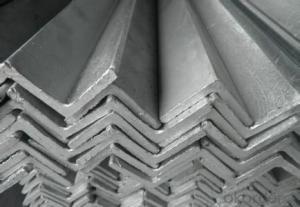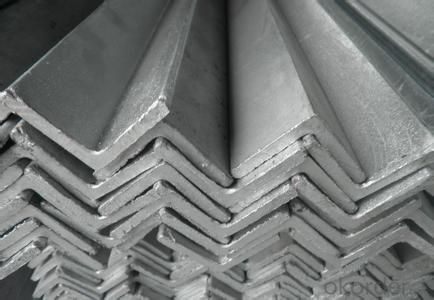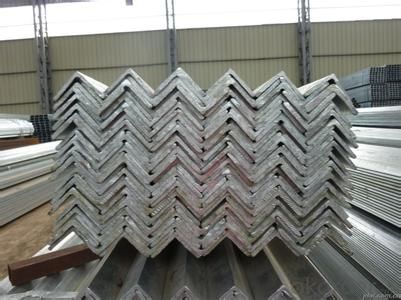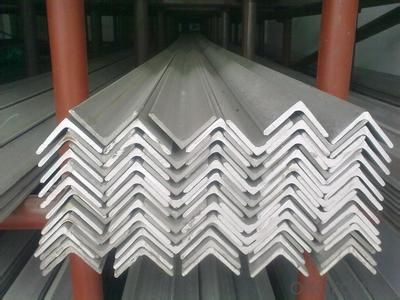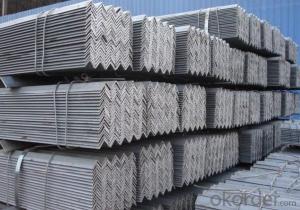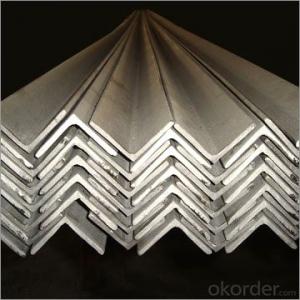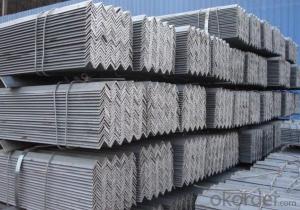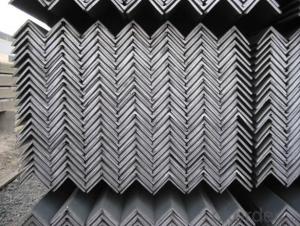GB Q235B 20-250MM equal angle steel High quality hot rolled
- Loading Port:
- Tianjin
- Payment Terms:
- TT OR LC
- Min Order Qty:
- 25 m.t.
- Supply Capability:
- 200000 m.t./month
OKorder Service Pledge
OKorder Financial Service
You Might Also Like
Angle Steel Details:
| Minimum Order Quantity: | 25mtons | Unit: | m.t. | Loading Port: | China Main Port |
| Supply Ability: | 80000-100000MTS/YEAR | Payment Terms: | TT or LC |
Product Description:
Specifications of Angle Steel
1. Invoicing on theoretical weight or actual weight as customer request
2. Length: 6m, 9m, 12m as following table
3. Sizes
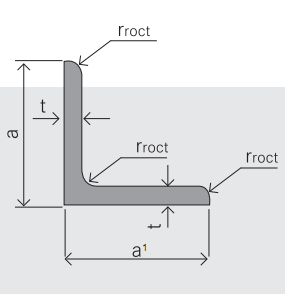
Sizes: 25mm-250mm | ||
a*t | ||
25*2.5-4.0 | 70*6.0-9.0 | 130*9.0-15 |
30*2.5-6.6 | 75*6.0-9.0 | 140*10-14 |
36*3.0-5.0 | 80*5.0-10 | 150*10-20 |
38*2.3-6.0 | 90*7.0-10 | 160*10-16 |
40*3.0-5.0 | 100*6.0-12 | 175*12-15 |
45*4.0-6.0 | 110*8.0-10 | 180*12-18 |
50*4.0-6.0 | 120*6.0-15 | 200*14-25 |
60*4.0-8.0 | 125*8.0-14 | 250*25 |
5. Payment terms:
1).100% irrevocable L/C at sight.
2).30% T/T prepaid and the balance against the copy of B/L.
3).30% T/T prepaid and the balance against L/C
6.Material details:
Alloy No | Grade | Element (%) | |||||
C | Mn | S | P | Si | |||
|
|
|
|
|
|
| |
Q235 | B | 0.12—0.20 | 0.3—0.7 | ≤0.045 | ≤0.045 | ≤0.3 | |
|
|
|
|
|
|
| |
Alloy No | Grade | Yielding strength point( Mpa) | |||||
Thickness (mm) | |||||||
≤16 | >16--40 | >40--60 | >60--100 | ||||
≥ | |||||||
|
|
|
|
|
| ||
Q235 | B | 235 | 225 | 215 | 205 | ||
Alloy No | Grade | Tensile strength (Mpa) | Elongation after fracture (%) | ||||
Thickness (mm) | |||||||
| ≤16 | >16--40 | >40--60 | >60--100 | |||
≥ | |||||||
|
|
|
|
|
|
| |
Q235 | B | 375--500 | 26 | 25 | 24 | 23 | |
Usage & Applications of Angle Steel
According to the needs of different structures, Angle can compose to different force support component, and also can be the connections between components. It is widely used in various building structures and engineering structures such as roof beams, bridges, transmission towers, hoisting machinery and transport machinery, ships, industrial furnaces, reaction tower, container frame and warehouse etc.
Packaging & Delivery of Angle Steel
1. Packing: it is nude packed in bundles by steel wire rod
2. Bundle weight: not more than 3.5MT for bulk vessel; less than 3 MT for container load
3. Marks:
Color marking: There will be color marking on both end of the bundle for the cargo delivered by bulk vessel. That makes it easily to distinguish at the destination port.
Tag mark: there will be tag mark tied up on the bundles. The information usually including supplier logo and name, product name, made in China, shipping marks and other information request by the customer.
If loading by container the marking is not needed, but we will prepare it as customer request.
Production flow of Angle Steel
Material prepare (billet) —heat up—rough rolling—precision rolling—cooling—packing—storage and transportation
Angle Steel Details:
| Minimum Order Quantity: | 25mtons | Unit: | m.t. | Loading Port: | China Main Port |
| Supply Ability: | 80000-100000MTS/YEAR | Payment Terms: | TT or LC |
Product Description:
Specifications of Angle Steel
1. Invoicing on theoretical weight or actual weight as customer request
2. Length: 6m, 9m, 12m as following table
3. Sizes

Sizes: 25mm-250mm | ||
a*t | ||
25*2.5-4.0 | 70*6.0-9.0 | 130*9.0-15 |
30*2.5-6.6 | 75*6.0-9.0 | 140*10-14 |
36*3.0-5.0 | 80*5.0-10 | 150*10-20 |
38*2.3-6.0 | 90*7.0-10 | 160*10-16 |
40*3.0-5.0 | 100*6.0-12 | 175*12-15 |
45*4.0-6.0 | 110*8.0-10 | 180*12-18 |
50*4.0-6.0 | 120*6.0-15 | 200*14-25 |
60*4.0-8.0 | 125*8.0-14 | 250*25 |
5. Payment terms:
1).100% irrevocable L/C at sight.
2).30% T/T prepaid and the balance against the copy of B/L.
3).30% T/T prepaid and the balance against L/C
6.Material details:
Alloy No | Grade | Element (%) | |||||
C | Mn | S | P | Si | |||
|
|
|
|
|
|
| |
Q235 | B | 0.12—0.20 | 0.3—0.7 | ≤0.045 | ≤0.045 | ≤0.3 | |
|
|
|
|
|
|
| |
Alloy No | Grade | Yielding strength point( Mpa) | |||||
Thickness (mm) | |||||||
≤16 | >16--40 | >40--60 | >60--100 | ||||
≥ | |||||||
|
|
|
|
|
| ||
Q235 | B | 235 | 225 | 215 | 205 | ||
Alloy No | Grade | Tensile strength (Mpa) | Elongation after fracture (%) | ||||
Thickness (mm) | |||||||
| ≤16 | >16--40 | >40--60 | >60--100 | |||
≥ | |||||||
|
|
|
|
|
|
| |
Q235 | B | 375--500 | 26 | 25 | 24 | 23 | |
Usage & Applications of Angle Steel
According to the needs of different structures, Angle can compose to different force support component, and also can be the connections between components. It is widely used in various building structures and engineering structures such as roof beams, bridges, transmission towers, hoisting machinery and transport machinery, ships, industrial furnaces, reaction tower, container frame and warehouse etc.
Packaging & Delivery of Angle Steel
1. Packing: it is nude packed in bundles by steel wire rod
2. Bundle weight: not more than 3.5MT for bulk vessel; less than 3 MT for container load
3. Marks:
Color marking: There will be color marking on both end of the bundle for the cargo delivered by bulk vessel. That makes it easily to distinguish at the destination port.
Tag mark: there will be tag mark tied up on the bundles. The information usually including supplier logo and name, product name, made in China, shipping marks and other information request by the customer.
If loading by container the marking is not needed, but we will prepare it as customer request.
Production flow of Angle Steel
Material prepare (billet) —heat up—rough rolling—precision rolling—cooling—packing—storage and transportation
- Q: Can steel angles be used in outdoor or corrosive environments?
- Yes, steel angles can be used in outdoor or corrosive environments. Steel angles are often made from low carbon steel or stainless steel, both of which have excellent corrosion resistance properties. Additionally, steel angles can be further protected from corrosion by applying coatings such as galvanization or painting. These protective coatings create a barrier between the steel and the corrosive elements in the environment, preventing rust and degradation. Therefore, steel angles are commonly used in outdoor structures, such as bridges, buildings, and industrial facilities, where they are exposed to moisture, saltwater, or other corrosive elements.
- Q: Unequal angle steel
- Unequal angle steel: in the field of engineering materials, relative to two equal side length equal angles, refers to the section of the right angle, L shaped, and unequal length of both sides of the angle. It is widely used in engineering structure, structure and variety of municipal public utilities, civil and military industries, such as industrial beams, bridges, towers, hoisting and conveying machinery, ships, industrial furnace, reaction tower, container frame, and warehouses, because the amount is less than the unilateral angle, so the relative price slightly higher.
- Q: What are the different corrosion protection methods for steel angles?
- There exists a range of corrosion protection methods for steel angles, which depend on the particular application and environmental conditions. Some commonly employed methods are as follows: 1. Galvanization: Coating the steel angles with a layer of zinc is a highly effective method of corrosion protection. The zinc layer acts as a sacrificial anode, corroding in place of the underlying steel. 2. Paint coatings: The application of a high-quality paint coating to the steel angles offers effective corrosion protection. The paint acts as a barrier, preventing moisture and corrosive substances from reaching the steel surface. 3. Powder coating: Similar to paint coatings, powder coating involves the application of a dry powder to the steel angles, followed by baking to create a durable and corrosion-resistant finish. 4. Epoxy coatings: For steel angles exposed to harsh environments or aggressive chemicals, epoxy coatings are commonly used. These coatings exhibit excellent adhesion and corrosion resistance. 5. Cathodic protection: This method involves the utilization of a sacrificial anode or impressed current to safeguard the steel angles from corrosion. The anode corrodes instead of the steel, providing long-lasting protection. 6. Barrier coatings: Barrier coatings, such as polyethylene or PVC wraps, create a physical barrier between the steel angles and the surrounding environment. This prevents moisture and corrosive substances from reaching the surface. 7. Hot-dip galvanizing: In this method, the steel angles are immersed in a bath of molten zinc, resulting in the formation of a thick zinc coating that offers superb corrosion protection. When selecting a corrosion protection method for steel angles, it is vital to consider the specific requirements of the application. Factors such as the environment, expected service life, and budget must be taken into account to ensure the most suitable method is chosen.
- Q: How do you cut steel angles to size?
- To cut steel angles to size, you can use various tools such as a hacksaw, angle grinder, or a band saw. Measure and mark the desired length on the steel angle, then secure it in a vise or clamp it down. Use the chosen cutting tool to carefully cut along the marked line, ensuring steady and controlled movements. It is important to wear appropriate safety gear, such as goggles and gloves, and to follow proper cutting techniques to ensure a clean and accurate cut.
- Q: How do you prevent steel angles from vibrating under dynamic loads?
- One possible way to prevent steel angles from vibrating under dynamic loads is by using damping techniques. Damping involves adding materials or structures that absorb or dissipate the energy generated by the vibrating steel angles. This can be achieved by attaching damping pads or strips made of viscoelastic materials to the steel angles, which help absorb and dissipate the vibration energy. Another approach is to incorporate dampers such as tuned mass dampers or friction dampers, which are designed to reduce vibrations by adding additional mass or introducing friction forces to counteract the dynamic loads. Proper design and reinforcement of the steel angles can also help to increase their stiffness and reduce the likelihood of vibration.
- Q: What is the maximum shear force for a steel angle?
- The maximum shear force for a steel angle depends on various factors such as the size, shape, and material properties of the angle. To determine the specific maximum shear force, it is essential to consult the relevant design codes, standards, or specifications that provide guidelines for calculating the shear capacity of steel angles.
- Q: How do steel angles compare to wooden or concrete structural elements?
- Steel angles possess several advantages over wooden or concrete structural elements. Firstly, their exceptional strength and durability are well-known. They have the ability to bear heavy loads and resist deformation, making them ideal for supporting large structures or bridges. In contrast, wooden elements are susceptible to rot, warping, and degradation over time, while concrete elements may develop cracks or suffer from corrosion. Moreover, steel angles offer a high level of versatility in terms of design and construction. They can be easily fabricated into various shapes and sizes, allowing for customized solutions to meet different structural needs. This flexibility is not easily attainable with wooden or concrete elements, as they are constrained by natural properties and construction techniques. Furthermore, steel angles provide excellent fire resistance compared to highly flammable wooden elements. Steel does not burn, and its structural integrity remains intact even in high-temperature environments. While concrete also offers fire resistance, steel angles have the added advantage of being lightweight, reducing the overall load on the structure. Another significant benefit of steel angles is their resistance to pests, such as termites or rodents, which can cause severe damage to wooden structures. Steel is impervious to these threats, ensuring long-term stability and reducing maintenance costs. However, there are also some drawbacks to using steel angles. One of the main concerns is the potential for corrosion, particularly in environments with high moisture or chemical exposure. Regular maintenance, including the application of protective coatings or galvanization, is necessary to prevent the formation of rust and maintain the structural integrity of the steel. Moreover, steel angles tend to have a higher initial cost compared to wooden elements. However, their long-term durability and reduced maintenance requirements often result in cost savings over time. In conclusion, steel angles offer numerous advantages over wooden or concrete structural elements, including superior strength, versatility, fire resistance, pest resistance, and long-term durability. However, it is important to consider factors such as corrosion prevention and upfront costs when deciding on the most suitable structural material for a specific project.
- Q: Can steel angles be used to create decorative elements in architecture?
- Definitely, decorative architectural elements can indeed be created using steel angles. These versatile angle irons can be easily manipulated to form a variety of shapes and designs. Cutting, bending, and welding them allows for the creation of intricate patterns, ornamental details, and decorative accents. Steel angles find application in various architectural features like railings, balusters, window grilles, door frames, brackets, and ornamental trims. Their strength and durability make them suitable for both indoor and outdoor use. Adding different coatings, such as paint or powder coating, can enhance their appearance and protect them from corrosion. Architects and designers often incorporate steel angles into modern and contemporary designs to impart an industrial, sleek, and minimalist touch. The clean lines and geometric shapes of steel angles bring a modern aesthetic to buildings and structures. Utilizing them to create unique and captivating patterns adds visual interest and a sense of style to architectural projects. Additionally, steel angles can be combined with other materials like glass, wood, or stone, to achieve a striking contrast and a harmonious blend of materials. This versatility offers infinite design possibilities, enabling architects to create truly personalized and distinctive decorative elements. In conclusion, steel angles can be effectively utilized to create decorative elements in architecture. Their versatility, strength, and potential for customization make them an ideal choice for architects and designers seeking to enhance the aesthetic appeal and uniqueness of their projects.
- Q: What are the different types of steel angles used in agricultural applications?
- There are several types of steel angles commonly used in agricultural applications, including L-shaped angles, C-shaped angles, and T-shaped angles. These angles are often used to provide structural support, reinforce joints, or serve as framing components in buildings, equipment, or fencing systems on farms.
- Q: How do you protect steel angles from abrasive wear?
- There are several ways to protect steel angles from abrasive wear. One effective method is to apply a protective coating or paint to the steel surface. This coating acts as a barrier between the steel and abrasive materials, preventing direct contact and reducing wear. It is important to choose a coating that is specifically designed for abrasion resistance, such as epoxy or polyurethane coatings. Another method is to use rubber or polyurethane liners. These liners can be attached to the steel angles, providing a cushioning effect and preventing direct contact with abrasive materials. They are commonly used in applications where the steel angles are subjected to high levels of abrasion, such as in mining or bulk material handling. In some cases, it may be necessary to reinforce the steel angles with additional materials. This can be done by welding or bolting on wear plates or inserts made of hardened materials such as chromium carbide overlay or ceramic. These materials have high resistance to abrasion and can significantly extend the lifespan of the steel angles in abrasive environments. Regular maintenance and inspection are also crucial in protecting steel angles from abrasive wear. By regularly inspecting the angles for signs of wear or damage, any issues can be addressed promptly, preventing further deterioration. Additionally, implementing proper lubrication and cleaning practices can help minimize the effects of abrasion on the steel angles. Overall, protecting steel angles from abrasive wear requires a combination of preventive measures, including coatings, liners, reinforcements, and regular maintenance. By implementing these strategies, the lifespan and performance of steel angles can be significantly improved in abrasive environments.
Send your message to us
GB Q235B 20-250MM equal angle steel High quality hot rolled
- Loading Port:
- Tianjin
- Payment Terms:
- TT OR LC
- Min Order Qty:
- 25 m.t.
- Supply Capability:
- 200000 m.t./month
OKorder Service Pledge
OKorder Financial Service
Similar products
Hot products
Hot Searches
Related keywords
